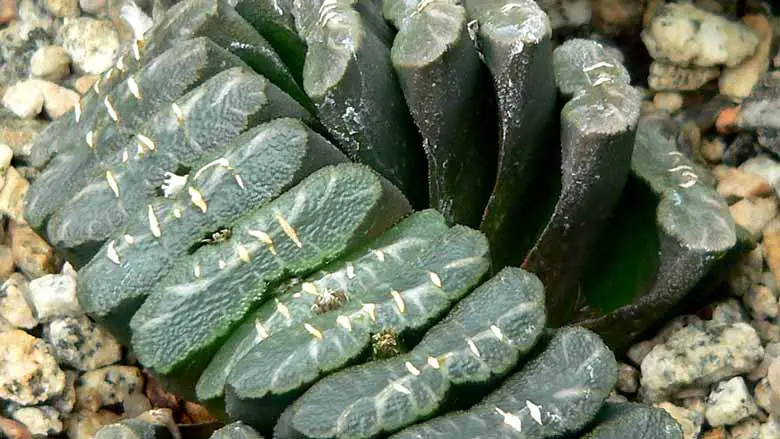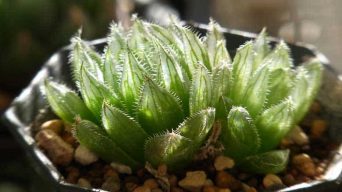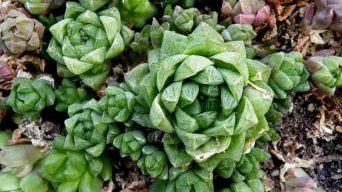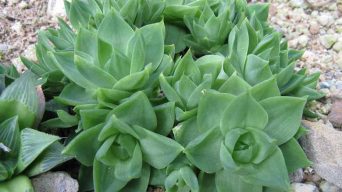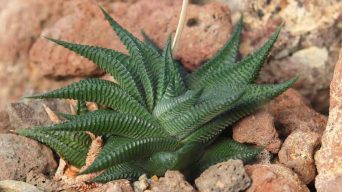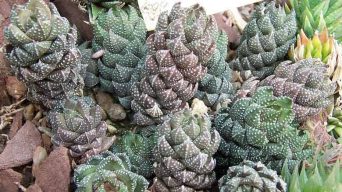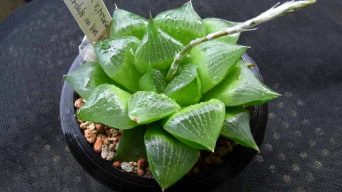Haworthia truncata plants, commonly known as Horse’s Teeth, are succulents that originate from South Africa.
They are very low-maintenance plants, making them perfect for those who want to keep their plants alive!
This guide will help you provide the best care for your Haworthia truncata plant and learn how to propagate this beautiful plant.
Overview
Haworthia truncata is a small succulent plant native to South Africa. They are leaf succulents that can grow to be about 1 inch in height and 4 inches in width with time.
Haworthia truncata is a small plant that is easy to identify by its thick leaves, which have a near-perfect rectangular cross-section and are arranged in a single row.
These succulent leaves are either gray or green and stay upright for the most part.
The specific epithet, “truncata,” derives its origin from the upper leaf surface, which gives the impression that it was cut off (or truncated).
How To Care for Haworthia Truncata
Haworthia Truncata care is relatively easy, but not all plants are created equally.
There is a range of quality and plant care that you need to know about before acquiring this succulent for your home or office environment.
Sun Exposure & Light Requirements
Haworthia truncata plants are not tolerant of direct sunlight and should be kept in a shaded spot with filtered light.
Direct sun will burn the leaves, which can lead to yellowing or brown spots on succulent margins.
If they need more bright light, they should be placed near a partially obscured window by tree branches or other objects such as curtains.
A north-facing windowsill may also provide enough indirect light for Haworthias during winter when there isn’t much natural lighting from the sun.
The best location would have bright but diffused daylight shining through it (like an east-facing window).
When grown outdoors, Haworthia truncata requires partial shade all day. Plant them under trees with dense canopies or in a shady area with other big, tall plants to provide some cover.
Watering Requirements
Haworthia truncata plants require a steady supply of water to survive. Without this, the leaves will wrinkle and dry up, eventually turning brown and dying off altogether.
To ensure that your succulent does not experience moisture loss or rot, make sure to thoroughly mist it at least once every two weeks with cold water from a spray bottle.
It is also important to note that Haworthia truncata plants are sensitive to overwatering–keep an eye on the soil for signs of excess liquid (muddy texture) before watering again!
You may be tempted to overwater your Haworthias as they can appear wilted from time to time. However, if you find yourself in this predicament, wait for the soil to dry up before watering again.
Soil Requirements
Haworthia truncata is a drought-tolerant succulent plant that grows best in well-draining potting soil.
The most popular potting media for this type of plant are succulents and cactus mix, perlite, clay pellets, or pumice stones.
No matter what you choose to use as the main component in your potting mix, it has to have excellent drainage capabilities because these plants do not like to sit in water which can cause root rot over time.
Put one part of peat moss or leaf mold into the container before adding anything else.
This will make your soil mix better because it is organic and will give it nutrients that are good for plants.
Temperature and Humidity
Haworthia truncata plants do well with a temperature of around 75 degrees Fahrenheit and humidity of between 45% to 60%.
They are very sensitive to too much heat, so make sure your plant has plenty of airflow.
The ideal humidity for this succulent ranges from 25% – 35%.
If the humidity is too high, the leaves will wilt. If the humidity is too low, then your plant may develop powdery mildew or rot.
Fertilizing
The Haworthia truncata plant is an easy-to-care-for succulent.
The best way to fertilize this plant is by using a diluted houseplant fertilizer monthly or a half-strength mixed in water every two weeks during the growing season.
When applying the diluted liquid, use only enough that will wet the soil’s surface. Do not let it pool on top of the soil and run down its sides.
Potting and Repotting
The best time to repot is when the Haworthia plant has outgrown its container. It would help if you used a pot with similar care needs to what your Haworthia truncata succulent prefers when that happens.
The best time to repot it is in the spring or summer, and make sure the soil mixture allows for aeration.
Place the plant in a pot with drainage holes. Be sure to use soil that is not too wet and has good drainage.
Ensure there are also no large air pockets around them, which can lead to root rot problems later on.
Use containers at least one size larger than your current pot, so you have room for growth without having to repot again soon.
Pruning
Pruning is not necessary with Haworthia truncata because the plant only grows a few inches in height.
If you want to trim it, cut off any dead leaves or stems as they occur.
You can also use pruning to make a Haworthia truncata into an interesting shape.
If so, we suggest cutting just above a node (where new growth arises) and then waiting for that area of the stem to grow entirely out before repeating it higher up on the stem.
The Haworthia will continue sprouting from nodes lower down on its stem while providing a nice branching effect in the process!
Pests and Diseases
Haworthia plants are tough little succulents. That’s why they’re great for beginners.
But, like any plant, Haworthia can be susceptible to pests and diseases if not cared for properly. Thankfully it isn’t too difficult to avoid these potential problems!
Read on below for a list of the most common pest and disease issues as well as what you should do about them:
Pests
Pests are attracted to unhealthy plants and can destroy them. If you notice any pests on your Haworthia plant, make sure to remove the problem ASAP.
The most common pests include:
- Scale (brown bumps)
- Mealybugs or cottony cushion scale (white specks that look like tiny worms)
- Fungus gnats and fruit flies (tiny black flying bugs that congregate around rotting fruits)
- Aphids (small annoying green bugs with pointy noses). They suck the sap out of leaves, weakening the plant’s overall health!
There are a few ways that you can remove these pests, including:
- Using yogurt or soap and water
- Natural predators like ladybugs
- Use neem oil spray on leaves.
These methods will help reduce pests without harming beneficial insects such as honeybees or other pollinators.
Pests, in general, aren’t too difficult to avoid if you keep an eye out for them!
Diseases
Haworthia will often get diseases if exposed to environments with high humidity or poor air circulation.
Two of the most common are powdery mildew and leaf spots.
Leaf spot can be prevented by avoiding overwatering, which causes plants not to have enough oxygen in their roots and leaves.
Powdery mildew is usually caused when a plant gets too much water on its surface (due to rain, for example).
It’s recommended that you try either increasing the humidity around your plant or decreasing it, so there isn’t much moisture on top of the root system of your Haworthia Truncata succulent!
The best way to fix these problems is by using fungicide spray!
Make sure you spray around the leaf and on top of its surface, as this will help treat any fungus that might be growing.
How to Care for Haworthia Truncata in Winter
Living in a temperate region, you might think that Haworthia Truncata care is the same as any other succulent. You would be wrong!
Depending on where it lives (in winter or summer), this plant requires different amounts of water and sunlight.
They are sensitive to direct sun exposure when dormant during cooler months.
Let’s take a closer look at how we can help our truncated cuties survive these cold winters in their natural habitat:
- Plant your Haworthias outside from April through October – this will allow enough time for them to grow before they experience freezing temperatures-
- Move plants indoors if frost threatens ̶ store them away from windows so that the sun won’t burn them while trying to warm up frozen soil.
- Plant your haworthias in a pot that’s at least 12 inches deep (or twice as deep if you live in areas with heavy frost) so that their roots are protected from freezing temperatures.
- Make sure to keep your haworthias at a temperature that’s above freezing (but not too cold) ̶ the optimal range is 50-65 degrees Fahrenheit with some variation depending on where you live.
- Give them as much light as possible – but be careful not to overheat their habitat and cause them stress or harm.
- Try not to water them as much in winter because they need less water. Only once every one or two weeks is enough, but keep an eye on their soil and adjust accordingly if needed.
They will also start shedding their leaves over winter, so there’s no point in watering them too enthusiastically then!
If you’re worried that your Haworthia might dry out entirely at this time of year, placing some moistened moss around its roots before putting it away for hibernation may be a good idea.
How To Propagate Haworthia Truncata
Haworthia truncata propagation is done by taking a leaf cutting from the plant and propagating it in soil.
Haworthia species are sensitive to root disturbance, so care should be taken when preparing plants for propagation.
A sharp knife or razor blade can be used to cut off healthy leaves for propagation. A small portion of the leaves tips should be cut horizontally.
The cut end will then need some time to callous over before being planted in moistened soil with gritty sand added as drainage material.
The new Haworthia succulent starts out looking like an ugly blob for up to six months.
After this period, they start developing leaves and roots, which emerge from the top of the calloused area where it was rooted into the soil.
After three or four years, the new plant will be a mature succulent ready for its own pot.
Is the Haworthia Truncata Toxic?
Haworthia Truncata is not typically toxic to humans or pets.
However, it is important to be cautious when handling this houseplant. It is always a good idea to wear gloves when handling this succulent.
It is also recommended to wash your hands after handling.
Final Thoughts
The Haworthia truncata is a beautiful succulent plant that can be propagated and nurtured in the home.
It’s essential to know how best to care for it and how to avoid pests or other potential problems while maintaining an indoor garden with this lovely plant.

